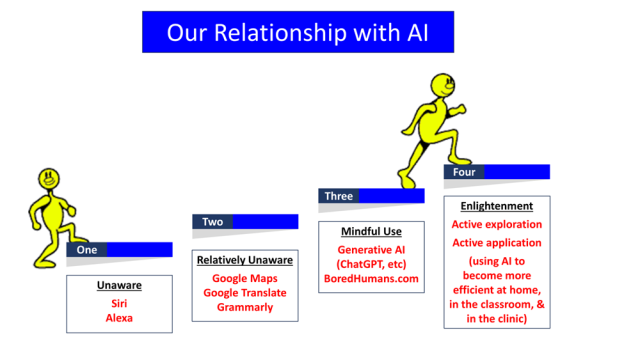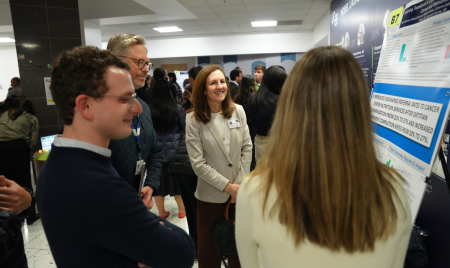MedEd Tech Tips: Our Relationship with AI

Four Steps in Our Relationship with AI
Happy new year from the Ed Tech Sig! As we launch into more focused technology tips this year, we wanted to start the year off by reflecting on our relationship with artificial intelligence (AI). AI has been everywhere for at least the last decade, whether or not you know you are using it. As an example, did you know google maps uses AI? What about your friend, Siri or Alexa?
To break down this relationship further and to set the stage for our future tips, we want to take a moment for you to reflect on your relationship with AI. In our proposed figure, your relationship with AI can be described in four stages or steps.
Step 1. Unaware
In this stage, you are likely using common applications that require AI to generate outcomes for you, but do not consider these applications “AI.” For example, as you talk to Siri on your phone, the computer is using principles of AI to generate an answer for you. Siri has been around for a very long time and you may not even consider Siri as a form of AI!
Step 2. Relatively Unaware
In this stage, you are aware that you are using some form of technology to assist or support your tasks; however, you are unaware that the application is powered by AI. For example, you may use Google Translate in your clinical practice to write or translate Spanish for your patients without thinking about the technology behind the program, but Google Translate uses AI to assist in the English or Spanish outputs.
Step 3. Mindful Use
In this stage, you have started using or experimenting with generative AI, which includes ChatGPT, Google Bard, or Microsoft’s Copilot (just to name a few), but have not found a place for it in your everyday routine. You may also feel a bit unsure about the role of AI, or even skeptical of AI, but are open to learning more and using it. An example would be going to boredhumans.com and generating memes to help provide a visual for one of your PowerPoint presentations.
Step 4. Enlightenment
In this stage, you have used generative AI platforms often enough to start applying these applications to your everyday responsibilities, such as teaching or clinical work. You may even start to think about how AI can work for you or come up with ideas of how to integrate AI into existing UCSF programs, like e-Value. As an example, many professional schools are discussing ways in which instructors can summarize student evaluations more efficiently, and have sought out AI to help them generate summary statements of evaluations from 50+ students.
Which step do you think you stand at the present time? Is this where you would like to be?
If you, like many, are currently on step 2, here are some links to common generative AI platforms in case you are interested in taking another step:









